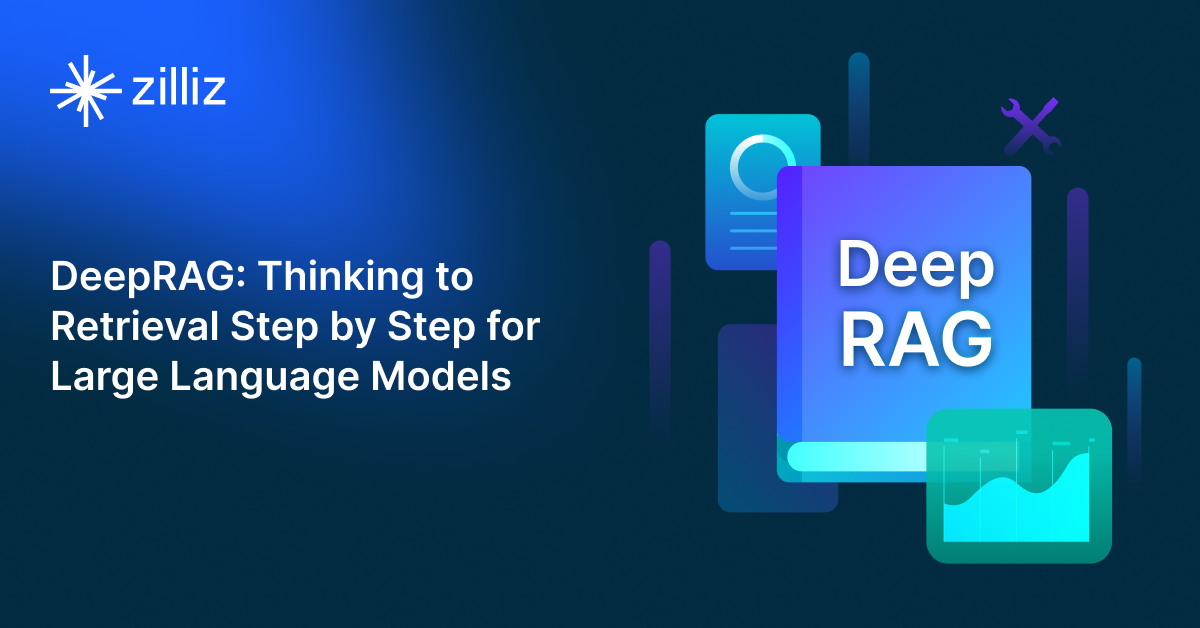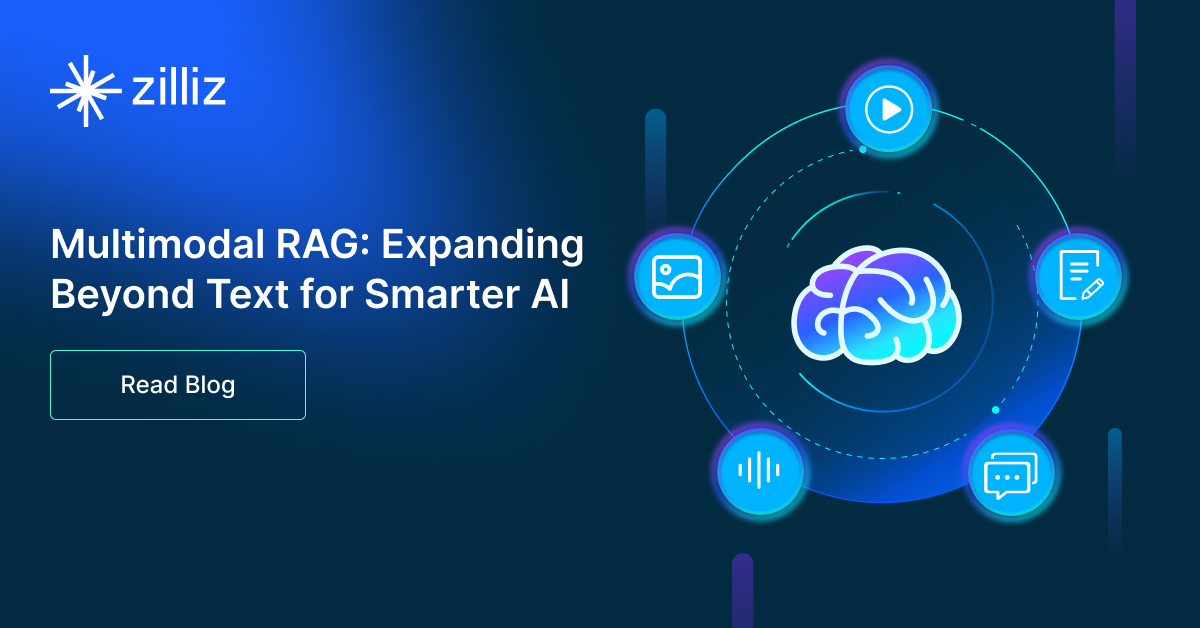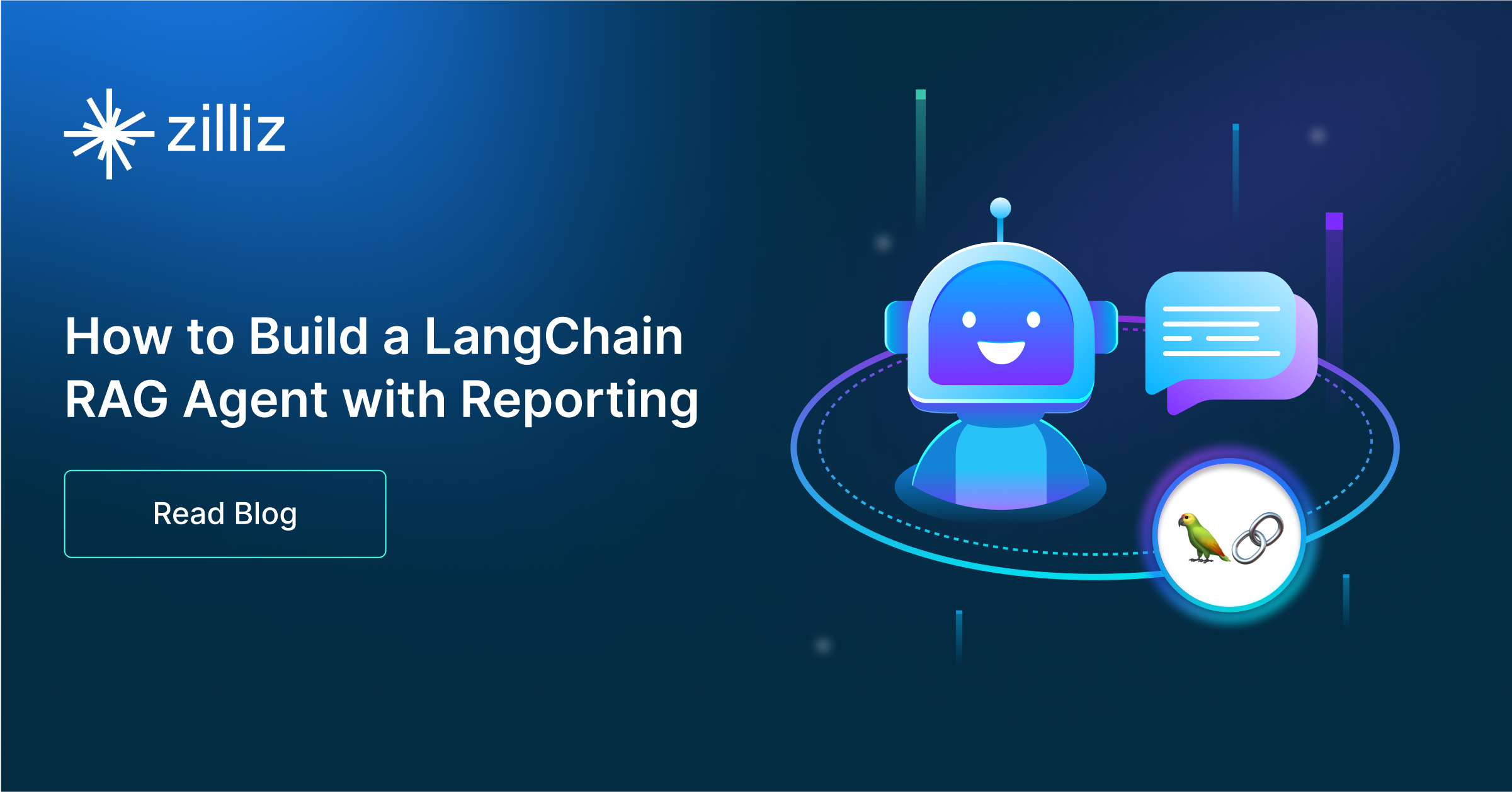Build RAG Chatbot with LangChain, LangChain vector store, Google Vertex AI Claude 3.5 Haiku, and Cohere embed-english-light-v3.0
Introduction to RAG
Retrieval-Augmented Generation (RAG) is a game-changer for GenAI applications, especially in conversational AI. It combines the power of pre-trained large language models (LLMs) like OpenAI’s GPT with external knowledge sources stored in vector databases such as Milvus and Zilliz Cloud, allowing for more accurate, contextually relevant, and up-to-date response generation. A RAG pipeline usually consists of four basic components: a vector database, an embedding model, an LLM, and a framework.
Key Components We'll Use for This RAG Chatbot
This tutorial shows you how to build a simple RAG chatbot in Python using the following components:
- LangChain: An open-source framework that helps you orchestrate the interaction between LLMs, vector stores, embedding models, etc, making it easier to integrate a RAG pipeline.
- LangChain in-memory vector store: an in-memory, ephemeral vector store that stores embeddings in-memory and does an exact, linear search for the most similar embeddings. The default similarity metric is cosine similarity, but can be changed to any of the similarity metrics supported by ml-distance. It is intended for demos and does not yet support ids or deletion. (If you want a much more scalable solution for your apps or even enterprise projects, we recommend using Zilliz Cloud, which is a fully managed vector database service built on the open-source Milvusand offers a free tier supporting up to 1 million vectors.)
- Google Vertex AI Claude 3.5 Haiku: This advanced AI model leverages Google's Vertex AI platform, offering robust capabilities for natural language processing and data analysis. Notable for its versatility and scalability, it excels in complex tasks like content generation and sentiment analysis, making it ideal for enterprises aiming to enhance decision-making with AI-driven insights.
- Cohere embed-english-light-v3.0: This model specializes in generating high-quality embeddings for English text, optimized for efficiency and low resource usage. It excels in tasks such as semantic search, clustering, and recommendation systems. Ideal for developers needing fast and scalable text representation capabilities in resource-constrained environments.
By the end of this tutorial, you’ll have a functional chatbot capable of answering questions based on a custom knowledge base.
Note: Since we may use proprietary models in our tutorials, make sure you have the required API key beforehand.
Step 1: Install and Set Up LangChain
%pip install --quiet --upgrade langchain-text-splitters langchain-community langgraph
Step 2: Install and Set Up Google Vertex AI Claude 3.5 Haiku
pip install -qU "langchain[google-vertexai]"
# Ensure your VertexAI credentials are configured
from langchain.chat_models import init_chat_model
llm = init_chat_model("claude-3-5-haiku@20241022", model_provider="google_vertexai")
Step 3: Install and Set Up Cohere embed-english-light-v3.0
pip install -qU langchain-cohere
import getpass
import os
if not os.environ.get("COHERE_API_KEY"):
os.environ["COHERE_API_KEY"] = getpass.getpass("Enter API key for Cohere: ")
from langchain_cohere import CohereEmbeddings
embeddings = CohereEmbeddings(model="embed-english-light-v3.0")
Step 4: Install and Set Up LangChain vector store
pip install -qU langchain-core
from langchain_core.vectorstores import InMemoryVectorStore
vector_store = InMemoryVectorStore(embeddings)
Step 5: Build a RAG Chatbot
Now that you’ve set up all components, let’s start to build a simple chatbot. We’ll use the Milvus introduction doc as a private knowledge base. You can replace it with your own dataset to customize your RAG chatbot.
import bs4
from langchain import hub
from langchain_community.document_loaders import WebBaseLoader
from langchain_core.documents import Document
from langchain_text_splitters import RecursiveCharacterTextSplitter
from langgraph.graph import START, StateGraph
from typing_extensions import List, TypedDict
# Load and chunk contents of the blog
loader = WebBaseLoader(
web_paths=("https://milvus.io/docs/overview.md",),
bs_kwargs=dict(
parse_only=bs4.SoupStrainer(
class_=("doc-style doc-post-content")
)
),
)
docs = loader.load()
text_splitter = RecursiveCharacterTextSplitter(chunk_size=1000, chunk_overlap=200)
all_splits = text_splitter.split_documents(docs)
# Index chunks
_ = vector_store.add_documents(documents=all_splits)
# Define prompt for question-answering
prompt = hub.pull("rlm/rag-prompt")
# Define state for application
class State(TypedDict):
question: str
context: List[Document]
answer: str
# Define application steps
def retrieve(state: State):
retrieved_docs = vector_store.similarity_search(state["question"])
return {"context": retrieved_docs}
def generate(state: State):
docs_content = "\n\n".join(doc.page_content for doc in state["context"])
messages = prompt.invoke({"question": state["question"], "context": docs_content})
response = llm.invoke(messages)
return {"answer": response.content}
# Compile application and test
graph_builder = StateGraph(State).add_sequence([retrieve, generate])
graph_builder.add_edge(START, "retrieve")
graph = graph_builder.compile()
Test the Chatbot
Yeah! You've built your own chatbot. Let's ask the chatbot a question.
response = graph.invoke({"question": "What data types does Milvus support?"})
print(response["answer"])
Example Output
Milvus supports various data types including sparse vectors, binary vectors, JSON, and arrays. Additionally, it handles common numerical and character types, making it versatile for different data modeling needs. This allows users to manage unstructured or multi-modal data efficiently.
Optimization Tips
As you build your RAG system, optimization is key to ensuring peak performance and efficiency. While setting up the components is an essential first step, fine-tuning each one will help you create a solution that works even better and scales seamlessly. In this section, we’ll share some practical tips for optimizing all these components, giving you the edge to build smarter, faster, and more responsive RAG applications.
LangChain optimization tips
To optimize LangChain, focus on minimizing redundant operations in your workflow by structuring your chains and agents efficiently. Use caching to avoid repeated computations, speeding up your system, and experiment with modular design to ensure that components like models or databases can be easily swapped out. This will provide both flexibility and efficiency, allowing you to quickly scale your system without unnecessary delays or complications.
LangChain in-memory vector store optimization tips
LangChain in-memory vector store is just an ephemeral vector store that stores embeddings in-memory and does an exact, linear search for the most similar embeddings. It has very limited features and is only intended for demos. If you plan to build a functional or even production-level solution, we recommend using Zilliz Cloud, which is a fully managed vector database service built on the open-source Milvus and offers a free tier supporting up to 1 million vectors.)
Google Vertex AI Claude 3.5 Haiku optimization tips
Claude 3.5 Haiku on Google Vertex AI is optimized for both efficiency and improved response quality. Enhance retrieval by applying relevance filtering before passing documents to the model. Keep prompts structured with clear separators between user queries and retrieved context. Adjust temperature (0.1–0.3) for optimal factual accuracy while tuning top-p for output control. Use Google Cloud’s serverless scaling to handle large query loads without performance degradation. Implement caching strategies for frequently requested information to reduce redundant API calls. If used alongside larger models, deploy Haiku for rapid responses in latency-sensitive scenarios, reserving complex reasoning for higher-tier models.
Cohere embed-english-light-v3.0 optimization tips
Cohere embed-english-light-v3.0 is optimized for lighter, faster embeddings in English language tasks. To maximize efficiency, preprocess input text by stripping out unnecessary words and standardizing formatting, which reduces computational load and speeds up embedding generation. Leverage vector compression techniques to reduce storage costs and improve retrieval performance. When managing large volumes of data, implement efficient search strategies like HNSW or product quantization to reduce time spent querying. Batch embedding operations to process multiple texts at once, minimizing the overhead from frequent API calls. Periodically update the embeddings to capture any changes in the dataset, ensuring freshness and accuracy in search results while optimizing storage.
By implementing these tips across your components, you'll be able to enhance the performance and functionality of your RAG system, ensuring it’s optimized for both speed and accuracy. Keep testing, iterating, and refining your setup to stay ahead in the ever-evolving world of AI development.
RAG Cost Calculator: A Free Tool to Calculate Your Cost in Seconds
Estimating the cost of a Retrieval-Augmented Generation (RAG) pipeline involves analyzing expenses across vector storage, compute resources, and API usage. Key cost drivers include vector database queries, embedding generation, and LLM inference.
RAG Cost Calculator is a free tool that quickly estimates the cost of building a RAG pipeline, including chunking, embedding, vector storage/search, and LLM generation. It also helps you identify cost-saving opportunities and achieve up to 10x cost reduction on vector databases with the serverless option.
 Calculate your RAG cost
Calculate your RAG cost
What Have You Learned?
What a journey we’ve just embarked on together! You’ve now mastered the integration of an impressive suite of components to create a cutting-edge Retrieval-Augmented Generation (RAG) system! Through our tutorial, you learned how to leverage the power of LangChain as the backbone framework that ties all these elements together seamlessly. It’s like the conductor of an orchestra, ensuring that each part works in perfect harmony.
The vector database utilized here allows for lightning-fast retrieval, enabling your applications to search through vast datasets effortlessly. Imagine the speed at which your users will access information — it's game-changing! Pair that with the conversational brilliance of the Google Vertex AI Claude 3.5 Haiku LLM, and you have a system that can engage and respond like a seasoned conversationalist. The embedding model has gifted you the ability to create deep semantic representations, enriching your data’s context so that your RAG system can produce accurate and relevant responses.
With optimization tips tucked in and our handy cost calculator at your disposal, you’re fully equipped to maximize performance while keeping an eye on the budget. Now, it’s your turn to take this knowledge and run with it! Dive into building, optimizing, and innovating your very own RAG applications. The possibilities are limitless, and I can’t wait to see what incredible solutions you’ll create. Go forth and unleash your creativity!
Further Resources
🌟 In addition to this RAG tutorial, unleash your full potential with these incredible resources to level up your RAG skills.
- How to Build a Multimodal RAG | Documentation
- How to Enhance the Performance of Your RAG Pipeline
- Graph RAG with Milvus | Documentation
- How to Evaluate RAG Applications - Zilliz Learn
- Generative AI Resource Hub | Zilliz
We'd Love to Hear What You Think!
We’d love to hear your thoughts! 🌟 Leave your questions or comments below or join our vibrant Milvus Discord community to share your experiences, ask questions, or connect with thousands of AI enthusiasts. Your journey matters to us!
If you like this tutorial, show your support by giving our Milvus GitHub repo a star ⭐—it means the world to us and inspires us to keep creating! 💖
- Introduction to RAG
- Key Components We'll Use for This RAG Chatbot
- Step 1: Install and Set Up LangChain
- Step 2: Install and Set Up Google Vertex AI Claude 3.5 Haiku
- Step 3: Install and Set Up Cohere embed-english-light-v3.0
- Step 4: Install and Set Up LangChain vector store
- Step 5: Build a RAG Chatbot
- Optimization Tips
- RAG Cost Calculator: A Free Tool to Calculate Your Cost in Seconds
- What Have You Learned?
- Further Resources
- We'd Love to Hear What You Think!
Content
Vector Database at Scale
Zilliz Cloud is a fully-managed vector database built for scale, perfect for your RAG apps.
Try Zilliz Cloud for Free


